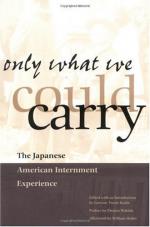|
This section contains 213 words (approx. 1 page at 300 words per page) |

|
Though the Issei were excluded from citizenship, their children— called Nisei—were American citizens by virtue of birth in the United States. The Issei, partly as a result of being excluded from American society, retained most of the customs and language of the old country and tried to pass them on to their children. The Nisei, however, were thoroughly American in culture (with the exception of a group called Kibei, who were sent to Japan for their education). They wore the same clothes as American children, spoke the same language, played baseball, and attended the same schools. Yoshiko Uchida writes:
In spite of the complete blending of Japanese qualities and values into our lives, neither my sister nor I, as children, ever considered ourselves anything other than Americans. At school we saluted the American flag and learned to become good citizens. All our teachers were...
|
This section contains 213 words (approx. 1 page at 300 words per page) |

|




